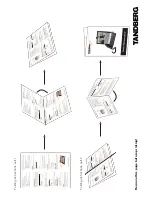
·
Accepts tone and rotary input
·
Ringing voltage source with short circuit protection
·
AC powered (battery not required)
·
Non-volatile memory (battery not required)
·
Generates precise call progress tones
·
Ground reference jack
·
-48 V ground referenced line voltage
·
Audio port
Calling Operations
The TLS-4A provides dial tone to a line when the telephone handset is lifted.
When a rotary dialed or tone digit is detected, dial tone stops. If a number is
misdialed, reorder tone (or another programmable tone) is sent to the caller or
the caller is connected to the audio port (see command 31 on page 34).
When a valid number has been dialed, ringback tone is sent to the caller and
the called line rings. When the called line answers, ringback tone stops and a
connection is established between the parties. When either party goes
on-hook, the off-hook line receives about 2 seconds (default) of silence,
followed by dial tone, or Cutoff on Disconnect. See command 38, Forced
Disconnect, on page 38 for more information.
Physical Description
The TLS-4A is a portable unit weighing just over 4 pounds. A detachable
power cord is supplied with the TLS-4A. As shown in Figure 1, the front panel
provides: four modular RJ-11 jacks for connection of the equipment to be
demonstrated or tested, a multifunction switch (see Table 1), and the
indicators listed in Table 2. A 5-pin DIN jack on the back panel enables
sending or receiving audio to/from any line. The audio is turned on or off by a
software-driven relay. A fused, modular AC power jack and an optional
chassis ground reference point are also located on the back of the unit.
For key telephone and PBX line testing, a modular/alligator clip cable can
(Figure 4) enable connection of lines from a
terminal block to the TLS-4A.
Telephone Line Simulator 4A
Page 2









































